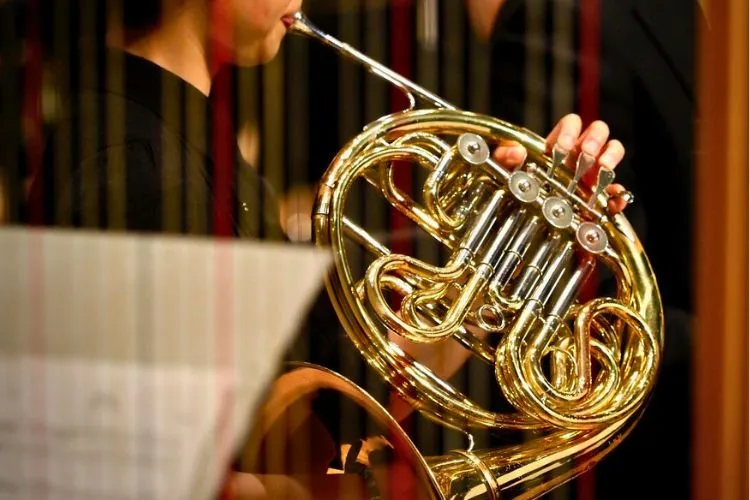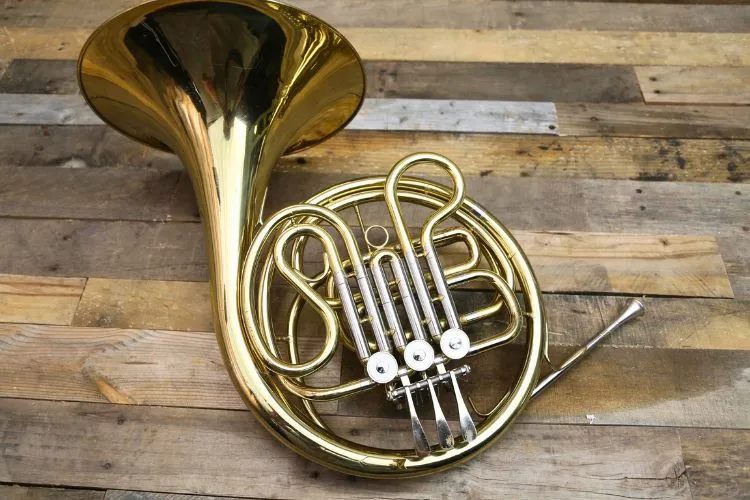When you think of a French horn, you probably picture its intricate brass coils and wide bell—not strings. Yet, there’s a lesser-known detail that surprises many: strings do play a role in the instrument’s mechanics.
This guide takes a closer look at how strings are used inside the valve system of the French horn, helping to control movement and ensure smooth performance. It’s a fascinating glimpse into the hidden complexity behind this iconic brass instrument.

The French horn stands out in the brass family for its distinct sound and design. Its mechanics involve a series of valves and levers that the player operates to change pitch.
At the heart of its operation lies the valve system, which can be either string-linked or mechanically linked.
Understanding these components is crucial to grasping the role strings may play in a French horn.
Contents
🎶Do French Horns Have Strings?
The answer is more nuanced than a simple yes or no. Some French horn models use strings as part of their valve mechanism. These strings connect the valve levers to the rotors, allowing for smoother operation.
In contrast, mechanical linkage uses all-metal connections. Each system has its proponents, but it’s essential to understand that string linkage is a legitimate design choice in horn manufacture.
🎶Importance of Strings in French Horns
Strings in a French horn play a vital role. They contribute to the horn’s overall responsiveness and can affect the ease with which a player can change notes. The material and condition of the strings can also influence the instrument’s sound.

Well-maintained strings can help produce a more mellow and precise tone, which is often sought after in classical music settings.
🎶Maintenance and Care
Taking care of the strings on a French horn is paramount for ensuring the instrument performs at its best. Regular checks are necessary to spot any signs of wear or fraying. Depending on usage, strings may need replacing every few years to maintain optimal functionality.
The process requires precision but does not necessarily need professional intervention. Proper care also involves keeping the horn and its strings clean and avoiding exposure to extreme conditions that could damage the strings.
🎶Choosing a French Horn: Strings or No Strings?
Deciding between a French horn with string linkage or mechanical linkage boils down to personal preference and playing context. Students or those new to the horn might prefer the more direct feel of mechanical linkages.

In contrast, more experienced players might value the nuance that string linkages can provide. Each type has its advantages, with string linkages often praised for their quieter operation and smoother feel.
🎶Pros and Cons of String vs. Mechanical Linkage
When choosing between string and mechanical linkage in French horns, it’s crucial to understand their respective advantages and disadvantages:
String Linkage
Pros
✅ Softer: String linkage operates more quietly than mechanical linkage, reducing key noise.
✅ Smoother: Many players feel that string linkage offers a smoother, more fluid playing experience.
Cons
❌ Durability: Over time, the strings can wear down, fray, or even break, requiring replacement.
❌ Maintenance: String linkage requires additional care and checking regularly to avoid unexpected breakages.
Mechanical Linkage
Pros
✅ Durability: Metallic components of mechanical linkage provide greater durability and longevity.
✅ Less Maintenance: Mechanical linkages require less maintenance compared to string linkage.
Cons
❌ Noise: Mechanical linkage often generates more noise during operation, which may be noticeable during softer passages of music.
❌ Feel: Some players find mechanical linkage less fluid or smooth compared to string linkage, which could impact playability.
Understanding your specific requirements, and being aware of these pros and cons, can help you make an informed decision when choosing between string and mechanical linkage for your French horn.
🎶How to Replace French Horn Strings?
Replacing strings on a French horn is an essential maintenance skill that can enhance your instrument’s performance. Follow these steps for a smooth replacement process:

- Gather Your Supplies: Ensure you have the new strings, a pair of scissors or a string cutter, and a cleaning cloth.
- Remove Old Strings: Carefully cut away the old strings from the valve levers and rotors. Use this opportunity to clean any accessible areas.
- Measure and Cut New Strings: Measure the new string against the old one, leaving a bit extra length for tying knots. Cut the string accordingly.
- Thread and Tie The Strings: Thread the new string through the lever arm and corresponding rotor spindle. Secure with a knot at both ends, trimming any excess string. Ensure the string is taut but not overly tight, as it needs a bit of flexibility for smooth operation.
- Test the Action: Gently operate the valve lever to ensure the rotor turns smoothly. Adjust the string tension if necessary.
- Repeat for Other Valves: Continue the process for each valve that requires a new string.
This guide can help maintain your French horn’s responsiveness and ensure lasting performance.
🎶Frequently Asked Questions (FAQs)
Under such conditions, strings might need replacing every two to three years. However, this varies based on the quality of the strings and how well they are maintained.
Yes, while traditional strings are made from nylon or similar materials, advancements have produced more durable alternatives. Exploring these options can be beneficial for horn players looking for longevity and reliability.
Snapping is rare but possible. In such instances, replacing the string is the best course of action. Keeping a spare set of strings and learning the replacement process can save time and ensure continuity in practice and performance.
Conclusion
Understanding the role of strings in the functionality of French horns adds a layer of depth to our appreciation of this complex instrument.
Whether you are a player or an enthusiast, knowing about these components, how to maintain them, and the impact they have on the instrument’s sound is invaluable.
Encouraging further exploration and proactive maintenance can enhance your musical journey with the French horn.
